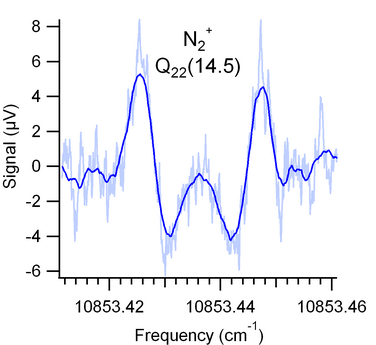First Signal Detected in Ion Beam
Michael Porambo
March 22, 2011 - 12:04 PM
The McCall group is pleased to announce the first detection of a spectroscopic signal in our fast ion beam instrument.

NICE-OHVMS signal of N2+ in the fast ion beam. The light blue trace is the (oversampled) raw signal from the experiment, while the dark trace is the same signal smoothed. Click for full size.
The McCall group ion beam team (Andrew Mills, Brian Siller, Dr. Holger Kreckel, Dr. Manori Perera, and Michael Porambo) has detected the first spectroscopic signal of a molecular ion in our fast ion beam machine. This detection is a significant milestone, representing a major step towards achieving our group's research goals. Observation of the signal, corresponding to the A 2Πu – X 2Σg+ Q22(14.5) transition of N2+, is not only the first to be had in our ion beam instrument, but it also represents the first time an electronic transition has been observed in an ion beam using a direct absorption technique.
For this detection, nitrogen was discharged in a cold cathode ion source and the resultant ions were extracted and formed into the fast ion beam. The beam was then turned 90° away from the source using electrostatic bender plates into a voltage modulated drift tube. The beam was overlapped with a continuous wave Ti:sapphire laser operating at ~921 nm. Several spectra were collected using Noise Immune Cavity Enhanced Optical Heterodyne Velocity Modulation Spectroscopy (NICE-OHVMS), a highly sensitive spectroscopic technique recently pioneered in the McCall group. These spectra were ensemble averaged to decrease the noise and uncover the signal. Subsequent optimization of the spectroscopy has now enabled observation of the signal after a single scan.

Block diagram of the ion beam setup.
Spectroscopy of the ion beam is an important step in the completion of Sensitive, Cooled, Resolved, Ion BEam Spectroscopy (SCRIBES). This is a novel technique that combines rotationally cooled ions, formation of a fast ion beam, ion-neutral discrimination, cavity-enhanced spectroscopy, and time-of-flight mass spectrometry to obtain high resolution spectra of molecular ions. Once completed, SCRIBES will be a powerful tool in the spectroscopic study of molecular ions. Much work remains to understand the properties of the signal and what they indicate about the ion beam, but seeing a signal constitutes an exceedingly important first step.
